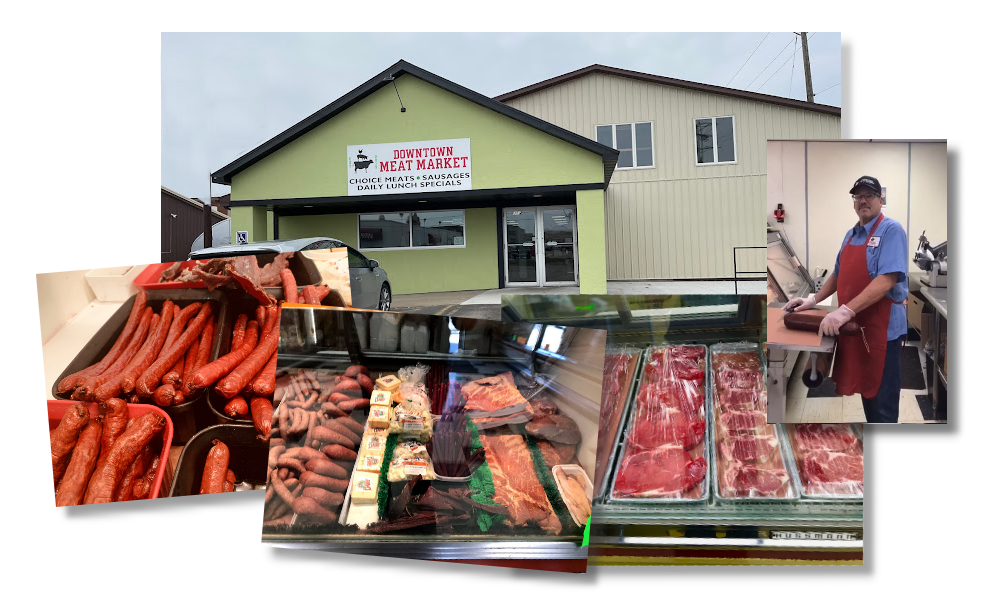Bagley Farms Meat Market Edwardsville IL: Your Go-To Location for Regional Meat Option
Bagley Farms Meat Market Edwardsville IL: Your Go-To Location for Regional Meat Option
Blog Article
Discover the Art of the Butcher's Cut in a Modern Meat Market
In the ever-evolving landscape of contemporary meat markets, the butcher's cut has actually transcended its standard roots, merging olden workmanship with contemporary methods. Today's butchers are not merely processors of meat; they are educated craftsmens that stress sustainability and honest sourcing. Their know-how in choose and preparing cuts customized to specific cooking demands supplies an exceptional eating experience. What really establishes the modern-day butcher apart is their capacity to create a much deeper connection in between consumers and the beginnings of their meat. Just how do these masters balance custom with advancement, and what effects does this have for the future of meat usage?
Evolution of Butchery Techniques
The evolution of butchery strategies shows an abundant tapestry of technology and adjustment driven by developments in innovation, modifications in customer need, and a deeper understanding of meat scientific research. Historically, butchery was a craft gave through generations, with approaches developed over centuries to make the most of yield and taste. However, the commercial revolution ushered in automation, transforming standard methods and making it possible for large handling.
The mid-20th century saw butchery techniques additionally improved by scientific insights into muscular tissue biology and meat aging, enhancing both tenderness and taste. Advancements like vacuum cleaner packaging and refrigeration expanded item shelf-life, permitting butchers to branch out offerings and enhance quality assurance. This duration additionally marked the rise of customized equipment, such as band saws and meat slicers, which increased accuracy and performance in meat processing.

Computerized systems now aid in tracking pet provenance and optimizing cuts to meet particular customer choices. Furthermore, a rebirth in artisanal butchery has actually arised, mixing standard abilities with modern understanding to cater to customers looking for moral and lasting meat alternatives.
Comprehending Meat Cuts
Comprehending the intricacies of meat cuts is essential for both butchers and consumers seeking quality and worth. For butchers, precise cuts mirror ability and respect for the craft, making sure minimal waste and optimal return.

Recognizing muscular tissue composition is crucial; muscular tissues made use of extra frequently by the pet tend to be harder and are best suited for slow-moving cooking techniques, while less-used muscular tissues, like those located in the loin, are much more tender and suitable for grilling or roasting. Familiarity with these differences encourages consumers to make educated options, enhancing their culinary undertakings.
Picking Top Quality Meat
Choosing the best meat entails even more than simply selecting an aesthetically enticing item from the screen. The art of picking high quality meat calls for a critical eye and knowledge of particular features that symbolize quality and excellence.
Secondly, consider the marbling, which refers to the white flecks of fat within the muscular tissue. Proper marbling is a crucial indicator of tenderness and taste, as it melts during food preparation, enhancing the meat's juiciness. Bear in mind, higher marbling frequently associates with superior top quality cuts, such as USDA Prime.
Structure is an additional important element; meat should really feel solid to the touch, not slimy or overly soft. Furthermore, be conscious of the scent. Fresh meat should have a clean, neutral smell, without any type of sour or repulsive odors.
Pairing Cuts With Cooking Methods

Alternatively, harder cuts like brisket More hints and chuck roast are abundant in collagen, which damages down into gelatin when prepared gradually. These cuts are ideal for braising or slow roasting, enabling the meat to tenderize gradually and create deep, complex tastes. Cuts such as short ribs and pork shoulder get on well with slow-cooking approaches, where extended cooking times transform their durable structures right into succulent dishes.
Lamb shanks and oxtail, which call for extended cooking to soften, are ideal prospects for stewing or slow simmering. These approaches coax out rich, passionate flavors while preserving wetness. By comprehending the unique attributes of each cut, cooks and home cooks alike can raise their culinary creations, guaranteeing each dish is both satisfying and memorable.
The Butcher's Role Today
Navigating the advancing landscape of the modern meat market, the butcher's duty today prolongs past simple preparation of cuts. Contemporary butchers are cooking artisans, educators, and advocates for sustainable methods. They connect the space in between the ranch and the fork by making sure moral sourcing, recognizing pet husbandry, and focusing on transparency in the supply chain. This shift shows the growing customer demand for top quality Website over quantity, where provenance and animal well-being are paramount.
In addition to crafting specific cuts, butchers now engage directly with customers, using cooking suggestions and customizing selections to fit specific needs and choices. Their know-how in meat aging, marbling, and flavor profiles equips customers to make informed decisions, boosting their culinary experiences. This tailored service exemplifies the butcher's developing function as a trusted expert in the cooking area.
Additionally, butchers are crucial in lessening waste, utilizing whole pets to develop diverse products such as sausages and stocks. This comprehensive method not only respects the animal yet likewise lines up with contemporary sustainability objectives. This way, the contemporary butcher personifies both custom and innovation, adapting to an ever-changing market while maintaining the creativity and stability of their craft.
Conclusion
The modern butcher's craft elaborately weaves standard techniques with contemporary developments, highlighting sustainable practices and ethical sourcing. Mastery in recognizing diverse meat cuts and high quality indications equips butchers to give informed recommendations, straightening certain cuts with ideal cooking methods. This experience not just elevates cooking experiences yet also reinforces the connection in between customers and the origins of their food. By honoring historical methods while accepting contemporary read this article demands, the butcher's role stays crucial in today's advanced meat market (bagley farms meat market edwardsville il).
Report this page